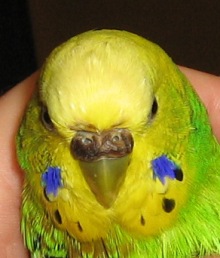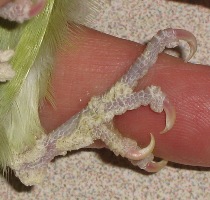Common Problems in Parakeets
Mites:
Parakeets that develop a thick scaley build-up on the beak and legs may be infected with a mite such as Knemidokoptes. This parasite can cause permanent deformities to the beak if left untreated. Treatment usually involves an antiparasitic drug such as ivermectin. If your parakeet has an unusual appearance to its beak or feet, a veterinary examination is needed to determine the underlying cause.
Scaley beak and feet that are caused by the bird mite Knemidokoptes.
An unhatched Knemidokoptes egg found in a skin scraping of a parakeet.
Fluffed, Poor Appetite, Diarrhea, Tail Bobbing, Breathing Problems:
These are all nonspecific signs that can be due to infections, poisoning, egg-laying, nutritional deficiencies, and a variety of other causes. Provide extra warmth to your parakeet and get it in to a veterinarian as soon as possible. Most problems are easier to treat when they first are detected. Waiting even a few days to see if your parakeet gets better can worsen its chance at recovery.
Excessive Egg Laying:
Some hens produce so many eggs in a short period of time that they become weak and even have seizures due to low blood calcium. This is a life-threatening emergency that requires immediate attention by a veterinarian.
Scratching & Feather-plucking:
A parakeet that scratches at itself often is likely suffering from an infection by the parasite Giardia or some other infection or internal disorder. Parakeets are much less likely to feather-pluck as a result of a behavioral issue than other parrots. If you see this behavior, collect several fresh moist fecal samples and place them in a Ziploc bag along with a moistened piece of paper towel. Keep this at room temperature and bring along to your visit to the veterinarian.
Abnormal dropppings:
A change in your parakeet's droppings is a cause for concern. Sometimes it can be linked to a change in the diet--perhaps you gave your parakeet a piece of grape earlier and its droppings seem more watery that afternoon. Usually, if it is due to a treat, the droppings will return to normal within a few hours. Other times it can be a sign of a serious illness such as an infection, kidney disease, liver disease, and many other problems. You should follow the advice above and collect several abnormal droppings to show the veterinarian.
This parakeet has "popcorn droppings". This is often attributed to infection with Giardia, but it can be caused by many other diseases.
Lameness:
In younger parakeets, this is often due to an injury such as a sprained or broken leg. In older parakeets lameness may signal a more serious internal problem such as a tumor. Tumors of the gonads and kidneys can often cause a parakeet to sit at rest holding one leg up or limp as it moves around on its perches.
Change in color of cere:
The cere is the area right at the base of the beak where the nostrils are located. In adult males it is bright blue while in females it is brown or tan. A change in the color or texture of the cere can be normal in aged parakeets or it may signal a seriously underlying illness.

The male parakeet's cere changed color due to a testicular tumor.




